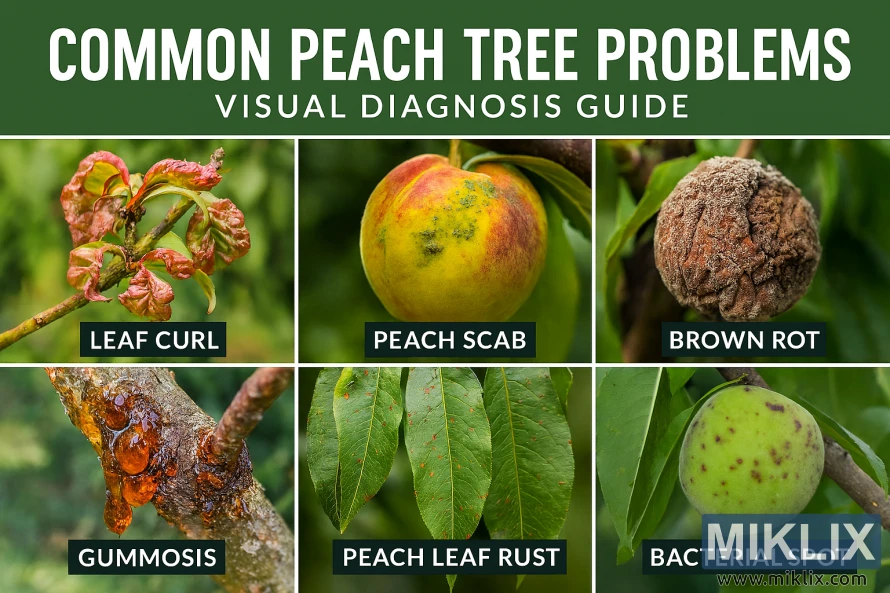Image: Visual Guide to Common Peach Tree Problems
Published: November 24, 2025 at 12:18:51 AM UTC
Explore a detailed visual guide to common peach tree problems including leaf curl, brown rot, bacterial spot, and pest damage. Ideal for gardeners and orchard managers.
This landscape-oriented educational image presents a comprehensive visual guide to diagnosing common peach tree problems. Set in a sunlit orchard with rows of peach trees in various stages of health, the image features six distinct diagnostic zones, each highlighting a specific issue affecting peach trees. The overall tone is informative and practical, designed to help gardeners, horticulturists, and orchard managers identify symptoms quickly and accurately.
In the top-left quadrant, 'Leaf Curl' is illustrated with a close-up of a peach twig bearing distorted, curled leaves tinged with red and yellow hues. The leaves appear thickened and blistered, a classic sign of Taphrina deformans infection. The background is softly blurred, emphasizing the affected foliage.
Adjacent to it, the 'Peach Scab' section shows a ripe peach with dark, velvety spots scattered across its skin. These lesions are indicative of Cladosporium carpophilum, and the surrounding leaves appear healthy, providing contrast to the blemished fruit.
The top-right quadrant features 'Brown Rot,' where a peach is visibly shriveled and covered in grayish mold spores. The fruit hangs limply from the branch, surrounded by green leaves, illustrating the destructive impact of Monilinia fructicola.
In the bottom-left quadrant, 'Gummosis' is depicted with a close-up of a tree trunk exuding amber-colored resin. The gummy sap oozes from a wound in the bark, suggesting stress or infection, possibly from Cytospora canker or mechanical damage.
The center-bottom section labeled 'Peach Leaf Rust' displays several green leaves speckled with small, round, reddish-orange pustules. These fungal spots are caused by Tranzschelia discolor and are distributed across the leaf surface, signaling early-stage infection.
Finally, the bottom-right quadrant shows 'Bacterial Spot' with a green peach covered in tiny, dark, sunken lesions. The surrounding leaves also exhibit small black spots along the veins, characteristic of Xanthomonas arboricola pv. pruni.
Each diagnostic zone is clearly labeled with bold white text on a dark green background, and thin white borders separate the sections for clarity. The top of the image features a title banner reading 'COMMON PEACH TREE PROBLEMS' in large, bold white letters, followed by 'VISUAL DIAGNOSIS GUIDE' in smaller capitalized text. The orchard background adds context and realism, reinforcing the practical utility of the guide.
This image serves as a valuable reference for anyone involved in peach cultivation, offering visual cues to identify and address tree health issues promptly.
The image is related to: How to Grow Peaches: A Guide for Home Gardeners

